Penn Vet alumni across generations have made and continue to make their mark in zoo, wildlife, and exotic animal medicine. And their work is nothing less than fascinating.
Imagine getting a call that an entire species is about to be wiped out, and you are the one to help save it. Well, that is exactly what happened to Charles Innis, V’94, an expert on turtle medicine and conservation, when he received a call from a Palawan turtle expert in the Philippines. During a warehouse raid, government officials had found 3,800 Palawan turtles stacked high, one upon the other. They were intended to become turtle soup.
Experts had thought the entire species numbered less than 3,800, so saving as many of the turtles as possible was vital to the survival of the species. Director of Animal Health at the New England Aquarium since 2005, Dr. Innis and three other veterinarians from around the world with turtle expertise quickly traveled to the Philippines, where they triaged and treated more than 1,000 turtles.
How many people can say that they safely removed a tiger from an apartment in Harlem, New York City? Robert Cook, V’80, can. His resume also includes providing health care for 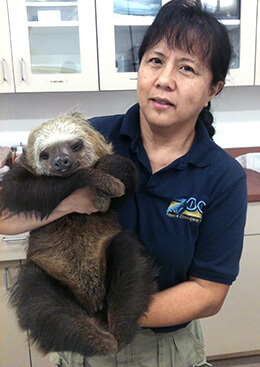 35 hand-raised baby gorillas and being part of the first successful aquarium beluga whale births, when he served as the Chief Veterinarian for 1,300 species in the Wildlife Conservation Society zoological parks.
35 hand-raised baby gorillas and being part of the first successful aquarium beluga whale births, when he served as the Chief Veterinarian for 1,300 species in the Wildlife Conservation Society zoological parks.
Then there is the late James Wright, V’51, whose distinguished career included working as a veterinarian at the National Zoo in Washington, D.C.; serving as a commissioned officer in the U.S. Public Health Service; and participating in projects for the Air Force—first at the Primate Laboratory in Texas and, later, at the Yerkes National Primate Research Center in Atlanta, where he worked with the U.S. Environmental Protection Agency as section chief and pathologist in the Health Effects Research Laboratory. He also served on the veterinary faculty of North Carolina State University as adjunct associate professor in the College of Veterinary Medicine.
After Dr. Wright’s passing, his son found papers regarding a trip he took to Senegal. The government was damming a river and seeking to save the area wildlife. Dr. Wright was called upon to help select the healthiest animals, determine how to immobilize them, and move them to their home in a newly established zoo. He helped refine the original dart gun and developed anesthetics in appropriate doses to be used as the tranquilizing agent.
Then there is Shirley Yeo Llizo, V’89, who you may recognize from her appearances on the pilot and an additional episode of Animal Planet’s Animal Cops: Houston. In one episode, she was subpoenaed as an expert witness in a confiscation case; in another, she assisted the state in transferring three circus brown bears to a wildlife sanctuary in east Texas. At the time, she worked at the Houston Zoo and assisted at the Houston SPCA when they had confiscations of wild and exotic animals. Prior to that, she served as the Head Veterinarian at the Singapore Zoo, having been recruited for that job just one year after graduation. She currently serves as the Veterinarian at the Topeka Zoo & Conservation Center.
Right up the street from Penn Vet at the Philadelphia Zoo, America’s first zoo, Tim Georoff, V’04, works as Associate Veterinarian. In addition to his regular duties at the Zoo, he serves as Co-Veterinary Advisor for the Association 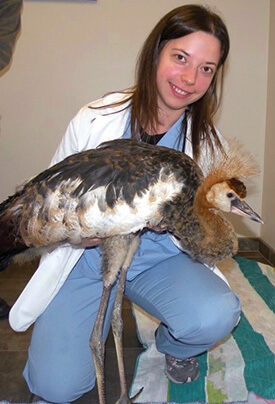 of Zoos and Aquariums’ Ring-Tailed Lemur Species Survival Plan Program. He has also provided veterinary support for several in situ and ex situ conservation projects,most recently with Panthera—assisting with a snow leopard GPS collaring project in Kyrgyzstan.
of Zoos and Aquariums’ Ring-Tailed Lemur Species Survival Plan Program. He has also provided veterinary support for several in situ and ex situ conservation projects,most recently with Panthera—assisting with a snow leopard GPS collaring project in Kyrgyzstan.
Wilbur Amand, V’66, joined the staff of the Philadelphia Zoological Society in 1974 as its first staff veterinarian, later to become the Curator of Mammals, Vice President for Animal Health and Biological Programs, and an interim Acting Director of the Philadelphia Zoo. At the Zoo, Dr. Amand developed a number of courses in avian, reptile/amphibian, and zoo mammal medicine. He has made his mark on the profession, having also served as Editor of the Journal of Zoo and Wildlife Medicine and Executive Director of the American Association of Zoo Veterinarians, the Association of Reptilian and Amphibian Veterinarians, and the American Academy of Veterinary Nutrition.
Dr. Amand is currently a member of the Animal Policy Committee of the National Aquarium in Baltimore, Maryland, and serves on the Board of Directors of Elephant Care International. He retired from Penn Vet as an Adjunct Professor of zoological medicine. He continues to mentor and guest lecture in the fields of companion exotic animal medicine as well as zoo and wildlife medicine.
A little further up the road, Adam Denish, V’93, oversees veterinary care for the residents of the Elmwood Park Zoo in Norristown, Pennsylvania. I had the privilege of recently observing a “day in the life” of Dr. Denish at Elmwood Park Zoo, where in one day he treated a Chacoan peccary named George, giraffes Jukuu and Dhoruba, a black rat snake, Anzona the kingsnake, Meteetsee the ferret, and several other species. With expertise in exotic and zoo animal medicine, he also has a private practice where his clientele includes the occasional monkey among other animals.
Amberly Sokoloff V’08 knew she wanted to focus on exotic pet medicine so she moved across the country for a residency in Companion Avian and Pet Exotic Medicine and Surgery at the University of California, Davis where she spent 3-years working with pet exotics, wildlife, and zoological collections. She has been in private practice in northern California since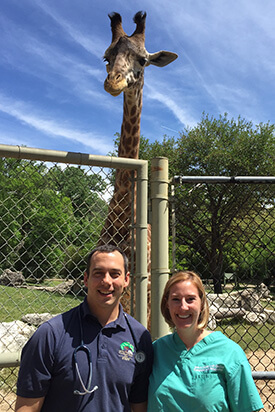 2012 where she has established an exotics department at a general practice as well as at an emergency/specialty hospital. She also enjoys educating fellow veterinarians and veterinary students on how to provide care to small furry, feathered, and scaled creatures through continuing education lectures and phone consultations.
2012 where she has established an exotics department at a general practice as well as at an emergency/specialty hospital. She also enjoys educating fellow veterinarians and veterinary students on how to provide care to small furry, feathered, and scaled creatures through continuing education lectures and phone consultations.
Howard Krum, V’92, helped launch both the Georgia Aquarium and the Georgia Sea Turtle Center. He was featured on the PBS TV series Scientific American Frontiers with Alan Alda, and his work with stranded sea turtles, large whales, and dolphins has been recognized on NBC Nightly News, various regional news stations, and in dozens of newspaper outlets including The Boston Globe. In addition, Dr. Krum’s contributions to help create the world’s largest aquarium were chronicled in the award-winning documentary Window to Wow/The Opening of the Georgia Aquarium, produced by WXIA-TV Atlanta.
After graduation, Dr. Krum’s classmate Roy Yanong, V’92, was hired by 5-D Tropical, Inc., a large ornamental fish farm in Plant City, Florida, where he plunged into the aquarium fish industry. In 1996, he joined the University of Florida (UF)/Institute of Food and Agricultural Sciences Tropical Aquaculture Laboratory in Ruskin, Florida, where he works today—providing extension, research, and educational programs in fish health management, including on-site veterinary assistance and disease diagnostic support for aquaculturists throughout the state. He also works closely with the Florida Fish and Wildlife Conservation Commission and Florida’s Department of Agriculture and Consumer Services. Roy is currently an associate professor and extension veterinarian in the Fisheries and Aquatic Sciences Program of the School of Forest Resources and Conservation, headquartered on UF’s main campus in Gainesville, Florida. He is a faculty member in the UF College of Veterinary Medicine’s Aquatic Animal Health Program.
Penn Vet alumni also do a great job of coming together to solve problems. When James Kusmierczyk, V’10, noticed a focal mass associated with the right eye of a female gerenuk at the Cameron Park Zoo in Waco, Texas, he invited the Ophthalmology Service and Zoo, Exotics, and Wildlife Service from the College of Veterinary Medicine & Biomedical Sciences at Texas A&M University to assist with a sedated ophthalmic 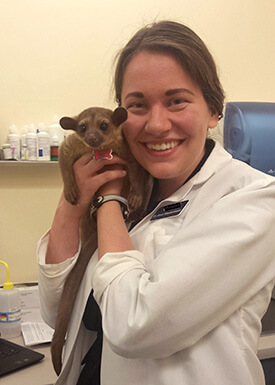 examination. Erin Scott, V’10, Clinical Assistant Professor of Ophthalmology at Texas A&M University, was able to determine that the mass was not a tumor as initially suspected, but a staphyloma. Staphylomas are focal regions of abnormally thinned sclera, the outer fibrous layer of the eye, that are lined by uveal tissue. They can appear as a tan, gray, or blue mass covered by conjunctiva. In the gerenuk’s case, this likely occurred secondary to an unknown trauma and, luckily, treatment was not necessary.
examination. Erin Scott, V’10, Clinical Assistant Professor of Ophthalmology at Texas A&M University, was able to determine that the mass was not a tumor as initially suspected, but a staphyloma. Staphylomas are focal regions of abnormally thinned sclera, the outer fibrous layer of the eye, that are lined by uveal tissue. They can appear as a tan, gray, or blue mass covered by conjunctiva. In the gerenuk’s case, this likely occurred secondary to an unknown trauma and, luckily, treatment was not necessary.
Definitely not everyday medicine for most veterinarians, Anne Staudenmaier, V’15, has done a wellness exam on a kinkajou, assisted delivery of chinchilla kits, amputated a tail on a ferret, and removed a snake stuck in concrete tubing. Dr. Staudenmaier is pursuing her passion in exotics with an internship and residency at Angell Animal Medical Center in Boston—and she said that she is loving every moment of it. She will be doing her residency to become boarded in avian medicine, along with an alternative track for exotic companion mammal and zoo medicine.
While studying biology at Harvard University, Christopher Bonar, V’91, assisted with field research on black rhinos in Kenya and the biomechanics of air breathing in lungfish. His post-doctoral internship was in wildlife medicine at the Wildlife Center of Virginia. Subsequently, he served as Zoo Veterinarian for the Fort Wayne Children’s Zoo in Fort Wayne, Indiana, and then as Associate Zoo Veterinarian for the Cleveland Metroparks Zoo in Cleveland, Ohio. He then moved to Dallas to be Chief Veterinarian for the Dallas World Aquarium, until moving to the Dallas Zoo in January 2013. He noted, “I actually went to Penn for veterinary school specifically to get into the zoo and wildlife medicine business, and it has led to a great career. I absolutely love what I do!”
Joe Gaydos, V’94, is a Senior Wildlife Veterinarian and the Chief Scientist for the SeaDoc Society, a science-based marine conservation program of the UC Davis Karen C. Drayer Wildlife Health Center. Also holding a PhD from the University of Georgia, he is a self-proclaimed “science nerd” with a passion for all things wild. For over a decade, Dr. Gaydos has been working on wildlife and ecosystem health 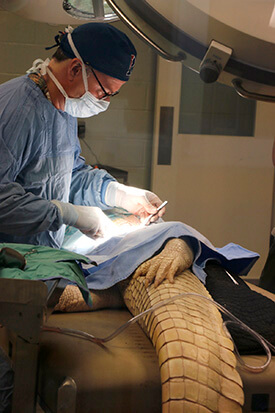 issues in the Pacific Northwest. He currently serves on Washington State’s Wildlife Diversity Advisory Council and co-authored a bestselling book, The Salish Sea: Jewel of the Pacific Northwest (2015, Sasquatch Books). As a wildlife veterinarian, Dr. Gaydos works to address diseases in wildlife at the individual animal level such as chemical immobilization of wildlife, surgically implanting satellite transmitters, and providing veterinary oversight for harbor seal rehabilitation. At the population level, he helps determine which diseases pose a risk to endangered killer whales. And as a translational scientist, he works to connect people to the amazing resources of the Salish Sea.
issues in the Pacific Northwest. He currently serves on Washington State’s Wildlife Diversity Advisory Council and co-authored a bestselling book, The Salish Sea: Jewel of the Pacific Northwest (2015, Sasquatch Books). As a wildlife veterinarian, Dr. Gaydos works to address diseases in wildlife at the individual animal level such as chemical immobilization of wildlife, surgically implanting satellite transmitters, and providing veterinary oversight for harbor seal rehabilitation. At the population level, he helps determine which diseases pose a risk to endangered killer whales. And as a translational scientist, he works to connect people to the amazing resources of the Salish Sea.
Paul Calle, V’83, joined the Wildlife Conservation Society (WCS) in 1989. As Chief Veterinarian and Director of the Zoological Health Program based at the Bronx Zoo, he oversees the Clinical, Pathology, and Aquatic Animal Medicine and Pathology Departments for WCS’s Zoos and Aquarium. He also chairs the WCS Institutional Animal Care and Use Committee (IACUC). During his tenure as Chief Veterinarian, a Molecular Diagnostics Laboratory has been created; health contributions to local conservation efforts have expanded; and participation in international wildlife health projects has increased, including those focused on a variety of turtle species and Caribbean ground iguanas. In support of WCS’s global conservation efforts, Dr. Calle has traveled to Asia, Russia, Latin America, and the Caribbean.
Donald Neiffer, V’92, Chief Veterinarian of the Smithsonian’s National Zoo in Washington, D.C., oversees the health care of the National Zoo’s entire animal collection of around 1,800 animals representing 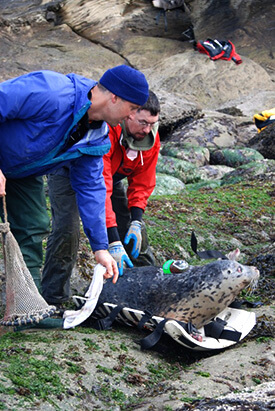 300 different species. He also leads and conducts clinical and conservation research and training programs within the Zoo’s Department of Animal Health. Dr. Neiffer previously served as the Director of Conservation Medicine at The Wilds, an affiliate of the Columbus Zoo and Aquarium. He also spent 16 years as Veterinary Operations Manager for Walt Disney World’s Animal Programs, where he implemented preventative health-care programs, oversaw collaborative and independent research, and managed medical cases.
300 different species. He also leads and conducts clinical and conservation research and training programs within the Zoo’s Department of Animal Health. Dr. Neiffer previously served as the Director of Conservation Medicine at The Wilds, an affiliate of the Columbus Zoo and Aquarium. He also spent 16 years as Veterinary Operations Manager for Walt Disney World’s Animal Programs, where he implemented preventative health-care programs, oversaw collaborative and independent research, and managed medical cases.
Gregory Lewbart, V’88, Professor of Aquatic, Wildlife, and Zoologic Medicine at North Carolina State University College of Veterinary Medicine, is a member of the Exotic Animal Medicine Service team and sees patients through this service in the NC State veterinary hospital and in the field. Dr. Lewbart founded the NC State CVM Turtle Rescue Team, and he is currently engaged in a multi-year field initiative in the Galápagos Islands—where he has productive collaborations with colleagues from the Universidad San Francisco de Quito, the Galápagos Science Center, the University of North Carolina, and the Galápagos National Park. He also serves as an Associate Editor for the Journal of Zoo and Wildlife Medicine and is a past President of the International Association for Aquatic Animal Medicine.
As a veterinarian, Jessica Dimuzio, V’78, specialized in wildlife preservation and had the opportunity to study wild baboons in Kenya, Africa. Soon after her studies ended, the land was sold to a cooperative of small farmers who regarded baboons as pests. The only way to save the baboons was to relocate them to a remote area of the country. The realization 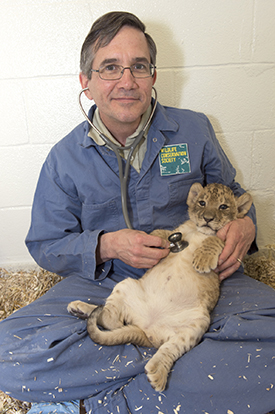 that land preservation was as vital as species studies led her, with her husband, Dr. Tim Halverson, to design holistic conservation education programs incorporating animal studies, land use, culture, and economics. They conducted these conservation programs for college students and wildlife biologists in the United States, Africa, and Asia.
that land preservation was as vital as species studies led her, with her husband, Dr. Tim Halverson, to design holistic conservation education programs incorporating animal studies, land use, culture, and economics. They conducted these conservation programs for college students and wildlife biologists in the United States, Africa, and Asia.
But it wasn’t enough. To create a lasting conservation impact, Dr. Dimuzio wanted to reach youngsters, inspiring them to connect with the natural world and revel in its mysteries. The enthusiasm of students in naturalist programs she leads in the U.S. and abroad has encouraged her to engage even more children by relating true stories from her work, through writing and speaking engagements.
The innovation and influence of VMDs in zoo, wildlife, and exotic medicine is far-reaching. We look forward to seeing how alumni continue to serve animals and ecosystems—and improve the world—through their veterinary skills and knowledge.
More Stories Wanted!
Are you a VMD working in the zoo, wildlife, or exotics field? Contact us with a photo and short bio to be profiled on the Penn Vet website in part two of our continuing coverage. Email the alumni office at kmcmul@vet.upenn.edu.